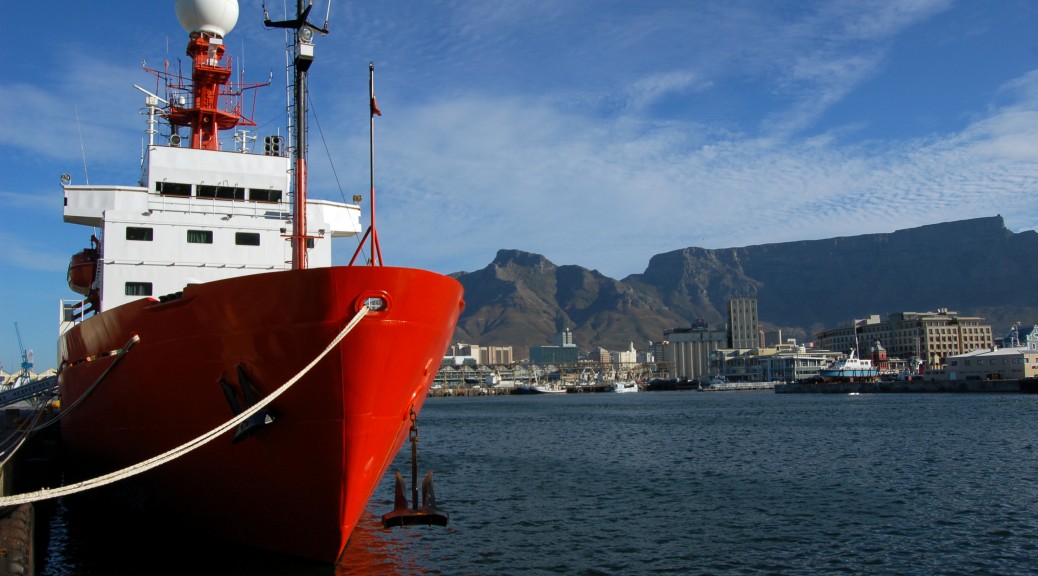Here’s my overview story about the Malaspina expedition for Nature’s news section. See the original at Nature’s website [html] or as it appeared in print: [pdf].
In the age of networked buoys and remote-sensing satellites, a global oceanographic cruise might sound like a relic from the golden era of exploration.
But the seven-month trek of Spain’s BIO Hespérides, which concludes next week when it docks in Cartagena, aims to deliver a global, comprehensive portrait of the ocean and how it is changing that the project’s backers say could not be assembled in any other way.
The Malaspina expedition, organized by Spain’s National Research Council (CSIC), set out on 15 December last year. Named after Alessandro Malaspina — who led a five-year survey of the Spanish empire’s natural history, economy and geography in the late eighteenth century — the €17-million (US$25-million) effort unites contributions from the Spanish Ministry of Science and Innovation, the Spanish Navy and the BBVA Foundation, the charitable arm of the BBVA banking consortium.
Most oceanographic voyages are shorter than the Malaspina expedition (see ‘Voyage of discovery’). By pouring resources into a single voyage, Malaspina’s planners hoped to gather global data sets in a wide variety of research areas, from the distribution of persistent organic pollutants to the discovery and genetic characterization of deep-sea life. They also wanted to follow the progress of carbon from the atmosphere as it sinks through the sea, gets captured in the planktonic food chain and eventually comes to rest on the ocean floor. And the scale of the effort has helped to attract international collaborators. Carlos Duarte, a marine biologist at the Mediterranean Institute for Advanced Studies in Esporles who led the mission, says that the approach was economical because loading instruments for one project costs less than changing instrumentation every month, as the research vessel would normally do.

“There are several other ocean exploration cruises going on, but Malaspina is a much more substantial scientific effort,” says marine biologist Larry Madin, director of research at the Woods Hole Oceanographic Institution in Massachusetts, who is not involved in the expedition. For instance, the Atlantic Meridional Transect is a 16-year-old British project that is making comparable multidisciplinary observations, but is restricted to the Atlantic. The few cruises with a global reach are mainly sailing boats, such as Craig Venter’s Sorcerer II Expedition or the French Tara Oceans expedition, which carry fewer sampling instruments and limited on-board research facilities.
By contrast, the 82.5-metre-long Hespérides lumbered across the sea bearing laboratories staffed around the clock by two dozen graduate students and veteran researchers from many disciplines. Investigators analysed each day’s instrument data and plankton catch on-board, allowing them to devise new observations on the fly. After Japan’s Fukushima nuclear accident in March, for example, the team began tracking radiation levels in its seawater samples. The researchers also tracked temperature, salinity and levels of dimethyl sulphide, a plankton waste product that may influence cloud formation above the ocean. And they froze viral and bacterial samples taken from a depth of 4 kilometres, planning to sequence the microbes’ genomes.
Duarte says that the modern-day Malaspina expedition achieved a major objective before it even left port: it persuaded hundreds of oceanographers to agree on common research objectives and methods. This approach should allow scientists to compare cruise data wherever they were gathered, says marine biogeochemist Eric Achterberg of the National Oceanography Centre in Southampton, UK, who is not part of the expedition. He and other researchers say that conflicting observational protocols often prevent researchers from comparing data sets taken by different teams in different oceans. Future expeditions could use the Malaspina protocols as a model. “We’re making the same observations around the world,” says María de Oca Echarte, a researcher at the Mediterranean Institute for Advanced Studies who took part in Malaspina.
The expedition should also fill gaps in global oceanographic data. Some regions visited by the Hespérides, such as the southern Indian Ocean and parts of the southern Pacific, see fewer oceanographic expeditions than do waters closer to the powerhouse nations of oceanographic research such as Germany, Japan, the United States and Britain. Madin says that the cruise’s data could keep researchers busy for many years, noting that results from HMS Challenger, a pioneering research cruise in the late nineteenth century, are still used by scientists today.
A few preliminary results emerged during the cruise. Investigators found that some plankton was sinking to the depths much faster than had been previously observed. If researchers confirm the measurements, and if such sinking is widespread, the discovery could affect estimates of how fast the ocean can sequester carbon.
But several scientists contacted by Nature say they are waiting to see more of Malaspina’s data before they decide whether it has met its goals. The expedition won funding that could have gone to projects in other disciplines, and occupied all of the Hespérides ‘ research time this year, so Spanish researchers will scrutinize its results and debate whether to conduct future oceanographic research projects along the same lines.
Physical oceanographer Álvaro Viúdez of the CSIC’s Institute of Marine Sciences in Barcelona says that the overarching goal of evaluating “global change” in the ocean is “an exaggerated objective, outside the capacity of an expedition of this type”. He adds: “The most relevant data for evaluating global change in the ocean are those collected by the thousands of Argo buoys, which have been collecting data for years, together with satellites.”
Viral molecular ecologist Matthew Sullivan, a collaborator on the Malaspina expedition at the University of Arizona in Tucson, says that time will prove the expedition’s worth: “Buy-in will happen a year or so from now when papers start to come out. People will see the value.”
